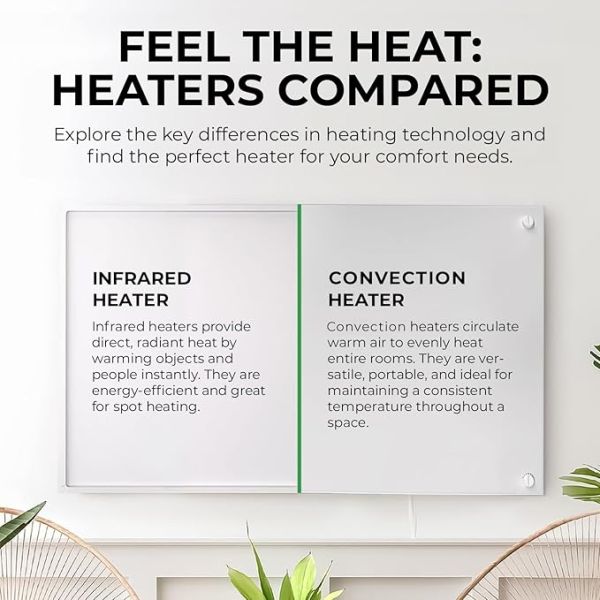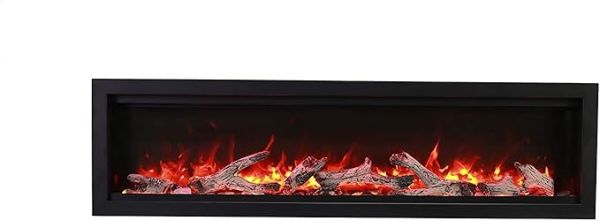How to Size a Heater: BTU/Watt Calculations and Heat-Loss Basics
- Understanding BTU and Watt Calculations
- What Is BTU?
- What Is Watt?
- Example Calculation
- How to Calculate Room Heating Requirements
- Heat-Loss Basics
- Sizing Chart for Quick Reference
- Tank vs. Tankless Portable Heaters
- Top 10 Heaters Compared
- Detailed Reviews
- 1. Dr. Infrared Heater Portable
- 2. De'Longhi Oil-Filled Radiator
- 3. Dyson Hot+Cool Jet Focus
- 4. Lasko Ceramic Tower Heater
- 5. Vornado VHEAT Vintage Heater
- 6. Honeywell HCE200W UberHeat
- 7. Heat Storm HS-1500-PHX
- 8. Comfort Zone CZ220
- 9. LifeSmart 6-Element Heater
- 10. Dyna-Glo Kerosene Heater
- Choosing the Right Heater for Your Home
- Buying Guide
- FAQs
- Conclusion
Sizing a heater correctly is one of the most important steps in ensuring comfort and efficiency in your home. An undersized heater will struggle to warm a room, while an oversized one wastes energy and increases bills. Many homeowners mistakenly buy heating equipment based solely on price or guesswork. The truth is, proper sizing depends on BTU (British Thermal Units), wattage calculations, and heat-loss basics.
This guide explains how to calculate the heating requirements for your home, the difference between BTU and watts, and how to account for insulation, room size, and climate. To make things even easier, we'll also compare 10 of the best heaters on Amazon, complete with features, pros/cons, reviews, and prices.
Understanding BTU and Watt Calculations
What Is BTU?
BTU stands for British Thermal Unit-a unit of measurement for heat. One BTU represents the amount of heat needed to raise the temperature of one pound of water by one degree Fahrenheit.
What Is Watt?
Watts measure electrical power. Since many heaters are rated in watts, you'll often need to convert between watts and BTUs.
Conversion Formula:
1 watt = 3.41 BTUs
or
BTUs = Watts × 3.41
Example Calculation
If you have a 1500-watt electric heater:
1500 × 3.41 = 5115 BTUs
This means your 1500W heater provides 5115 BTUs of heat output.
How to Calculate Room Heating Requirements
-
Measure Room Size
Multiply length × width × height to get cubic footage. -
Determine Required BTUs
General rule:
-
20 BTUs per square foot for mild climates.
-
30-35 BTUs per square foot for colder climates.
-
Adjust for Insulation
-
Poor insulation = add 15-20%.
-
Good insulation = subtract 10%.
-
Account for Room Features
-
Large windows: +15%.
-
High ceilings: +20%.
-
Open floor plans: +25%.
Heat-Loss Basics
Heat naturally escapes from warm areas to colder areas. Factors affecting heat loss include:
-
Windows: Poorly insulated windows lose 25-40% of heat.
-
Walls & Insulation: R-value determines resistance to heat loss.
-
Air Leakage: Gaps and drafts reduce heating efficiency.
-
Flooring: Tile and concrete floors retain cold.
Understanding heat loss helps you pick a heater with enough capacity to maintain comfort.
Sizing Chart for Quick Reference
| Room Size (sq. ft.) | Mild Climate (BTUs) | Cold Climate (BTUs) | Approx. Heater Wattage |
|---|---|---|---|
| 100-150 | 2,000-3,000 | 3,000-4,500 | 600-1,200 W |
| 150-250 | 3,000-5,000 | 4,500-7,500 | 900-2,200 W |
| 250-400 | 5,000-8,000 | 7,500-12,000 | 1,500-3,500 W |
| 400-600 | 8,000-12,000 | 12,000-18,000 | 2,500-5,300 W |
| 600-800 | 12,000-16,000 | 18,000-24,000 | 3,500-7,000 W |
Tank vs. Tankless Portable Heaters
-
Tank heaters (oil-filled radiators) retain heat longer but take time to warm up.
-
Tankless heaters (fan-forced or ceramic) provide instant heat but cool down quickly.
Top 10 Heaters Compared
| Model | Type | Price (Amazon) | BTU Output | Pros | Cons | Avg. Rating |
|---|---|---|---|---|---|---|
| Dr. Infrared Heater Portable | Infrared | $129 | 5,200 | Energy-efficient, quiet | Bulky | 4.6/5 |
| De'Longhi Oil-Filled Radiator | Oil-filled | $109 | 5,120 | Long-lasting heat | Slow warm-up | 4.6/5 |
| Dyson Hot+Cool Jet Focus | Ceramic Fan | $399 | 5,118 | Stylish, dual heat/cool | Expensive | 4.5/5 |
| Lasko Ceramic Tower Heater | Ceramic | $79 | 5,100 | Affordable, compact | Limited range | 4.6/5 |
| Vornado VHEAT Vintage Heater | Fan-forced | $129 | 5,118 | Retro design, strong airflow | Noisy at high setting | 4.6/5 |
| Honeywell HCE200W UberHeat | Ceramic | $54 | 5,118 | Small, portable | Limited to small rooms | 4.5/5 |
| Heat Storm HS-1500-PHX | Infrared Wall | $139 | 5,200 | Wall-mount, Wi-Fi control | Needs outlet nearby | 4.6/5 |
| Comfort Zone CZ220 | Garage Heater | $239 | 7,500 | Powerful, industrial use | Loud fan | 4.5/5 |
| LifeSmart 6-Element Heater | Infrared | $129 | 5,200 | Remote control, even heat | Heavy | 4.5/5 |
| Dyna-Glo Kerosene Heater | Kerosene | $169 | 10,000 | Powerful, off-grid use | Needs fuel refills | 4.6/5 |
Detailed Reviews
1. Dr. Infrared Heater Portable
Compact yet powerful, this infrared heater delivers consistent warmth for medium rooms.
Pros: Remote control, quiet fan, dual heating system.
Cons: Takes up floor space.
Customer Review: "Keeps my living room warm without spiking my bills."
2. De'Longhi Oil-Filled Radiator
Classic oil-filled design with efficient heat retention.
Pros: Silent operation, safe for overnight use.
Cons: Slow to heat up.
Customer Review: "Perfect for bedrooms-runs all night with steady warmth."
3. Dyson Hot+Cool Jet Focus
Premium heater with futuristic design and dual functionality.
Pros: Stylish, air purifier-like look, works year-round.
Cons: High price.
Customer Review: "Worth the investment-modern and powerful."
4. Lasko Ceramic Tower Heater
Budget-friendly tower heater ideal for small to medium rooms.
Pros: Oscillation, compact design, affordable.
Cons: Limited BTU for large rooms.
Customer Review: "A lifesaver during winter in my office space."
5. Vornado VHEAT Vintage Heater
Retro design paired with modern fan-forced heating.
Pros: Strong airflow, stylish.
Cons: Louder at high speeds.
Customer Review: "I love the look and feel. Very effective in my study."
6. Honeywell HCE200W UberHeat
Affordable compact ceramic heater.
Pros: Portable, budget option.
Cons: Only suitable for small spaces.
Customer Review: "Tiny but mighty. Perfect for my dorm room."
7. Heat Storm HS-1500-PHX
Infrared wall-mounted heater with Wi-Fi control.
Pros: Saves space, smart app integration.
Cons: Requires wall outlet nearby.
Customer Review: "Love the wall mount design. Heats my office perfectly."
8. Comfort Zone CZ220
Industrial-grade garage heater.
Pros: High BTU output, durable.
Cons: Noisy.
Customer Review: "My garage finally stays warm even in freezing weather."
9. LifeSmart 6-Element Heater
Infrared heater with multiple elements for even heat.
Pros: Remote, large coverage.
Cons: Heavy to move.
Customer Review: "Keeps my family room consistently warm. Easy to use."
10. Dyna-Glo Kerosene Heater
Portable kerosene heater with powerful output.
Pros: Off-grid heating, high BTU.
Cons: Needs fuel refills.
Customer Review: "Perfect for our cabin. Strong heat even without electricity."
Choosing the Right Heater for Your Home
-
Small Rooms: Compact models like Honeywell UberHeat or Lasko Ceramic.
-
Large Spaces: Industrial heaters like Comfort Zone CZ220 or Dyna-Glo.
-
Eco-Friendly: Infrared models like Heat Storm with Wi-Fi control.
-
Luxury Buyers: Dyson Hot+Cool for dual-purpose design.
-
Budget Buyers: Honeywell or Lasko entry-level ceramic heaters.
Buying Guide
-
Calculate BTU needs - Use the sizing chart.
-
Match to climate - Cold climates require higher BTUs.
-
Consider insulation - Poor insulation demands more power.
-
Decide heater type - Infrared for efficiency, oil-filled for long warmth, ceramic for budget.
-
Safety features - Look for tip-over and overheat protection.
FAQs
Q: How do I convert watts to BTUs?
A: Multiply watts by 3.41.
Q: Can one heater cover my whole house?
A: Usually no. Heaters are best sized for individual rooms.
Q: What's most energy-efficient?
A: Infrared and oil-filled heaters tend to use energy more effectively.
Conclusion
Sizing a heater correctly ensures comfort, efficiency, and lower energy bills. By calculating BTUs or wattage based on room size, insulation, and climate, you can choose the right heater for your space. Whether you need a compact ceramic unit or a high-powered industrial heater, the right choice depends on your unique home environment.







